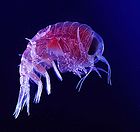- Milky seas effect
-
 Milky seas effect
Milky seas effect
Milky seas is a condition on the open ocean where large areas of seawater (up to 6,000 square miles) are filled with bioluminescent bacteria, causing the ocean to uniformly glow an eerie blue at night. The condition has been present in mariner's tales for centuries – notably appearing in chapter 24 of Jules Verne's Twenty Thousand Leagues Under the Sea – but until recently it has not been rigorously documented. There have been 235 documented sightings of milky seas since 1915 - mostly concentrated in the north-western Indian Ocean and near Indonesia.
In 1985 a research vessel in the Arabian Sea took water samples during milky seas. Their conclusions were that the effect was caused by the bacteria Vibrio harveyi.
In 2005, Steven Miller of the Naval Research Laboratory in Monterey, California, was able to match 1995 Satellite images with a first-hand account of a merchant ship. U.S. Defense Meteorological Satellite Program showed the milky area to be approximately 15,400-km² (roughly the size of Connecticut). The luminescent field was observed to glow over three consecutive nights.
While monochromatic photos make this effect appear white, Monterey Bay Aquarium Research Institute scientist Steve Haddock (an author of a milky seas effect study) has commented, "the light produced by the bacteria is actually blue, not white. It is white in the graphic because of the monochromatic sensor we used, and it can appear white to the eye because the rods in our eye (used for night vision) don't discriminate color." [1]
References and further reading
- Detailed discussion and images of milky sea observation
- BBC News: 'Milky seas' detected from space
- Miller, S.D., S.H.D. Haddock, C.D. Elvidge, T.F. Lee. Detection of a bioluminescent milky sea from space. Proceedings of the National Academy of Sciences. v102:14181-14184 Abstract
- Nealson, K.H. and J.W. Hastings (2006) Quorum sensing on a global scale: massive numbers of bioluminescent bacteria make milky seas Appl. Environ. Microbiol. 72:2295-2297. Manuscript
- Milky Sea Account from a sailing yacht in the India Ocean 2006
Categories:- Bioluminescence
- Biological oceanography
- Aquatic ecology
Wikimedia Foundation. 2010.


